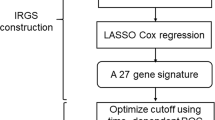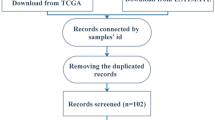Abstract
Purpose
We aim to develop an immune-score nomograms for predicting overall survival (OS) of patients with HNSCC and assess the association of immune scores with prognosis.
Methods
The data of 530 patients used in this study were retrieved from The Cancer Genome Atlas database. The optimization cut‐point for immune scores was expressed by X-tile 3.6.1 tool. Possible prognostic factors from univariate Cox analysis were further included in a multivariate Cox proportional hazards analysis to obtain significant risk factors. Prognostic nomograms were constructed based on the factors of significant multivariate prognostic using R version 3.5.1. A calibration map was generated by comparing the nomogram prediction probability and the observation for the 3-year and 5-year OS rates.
Results
We retrospectively analyzed 462 patients downloaded from TCGA dataset. Prognostic nomograms was integrated following risk factors of significant multivariate prognostic, such as age, angiolymphaic invasion (AI), perineura invasion(Per_invasion),tumor site, immune score, tumor-node-metastasis(TNM) stage. The concordance Index (C-index) for OS predictions was 0.723 (95% CI 0.671–0.785). Moreover, we compared the powerful efficiency of the nomograms with that of the TNM staging system. OS prediction determined on immune score set compared with the TNM staging with C-index = 0.723 vs 0.612. The calibration curves for the probability of OS of 3-year or 5-year showed no deviations between the prediction by nomograms and actual reference line.
Conclusion
The present study indicate that high and intermediate immune scores are as independent prognostic variables for OS of head–neck squamous cell carcinoma patients. We constructed novel nomograms may has the potential to provide individualized survival risk assessments and guide treatment decisions.





Similar content being viewed by others
Data availability statement
The data used to support the findings of this study are included within the article.
Abbreviations
- AI:
-
Angiolymphaic invasion
- AJCC:
-
American Joint Committee on Cancer
- C-index:
-
Concordance Index
- HNSCC:
-
Head and neck squamous cell carcinoma
- HPV:
-
Human papillomavirus
- OS:
-
Overall survival
- TNM:
-
Tumor-node-metastasis
References
Bray F, Ferlay J, Soerjomataram I, Siegel RL, Torre LA, Jemal A (2018) Global cancer statistics 2018: GLOBOCAN estimates of incidence and mortality worldwide for 36 cancers in 185 countries. Cancer J Clin 68(6):394–424. https://doi.org/10.3322/caac.21492
Yom SS, Mallen-St Clair J, Ha PK (2017) Controversies in Postoperative Irradiation of Oropharyngeal Cancer After Transoral Surgery. Surg Oncol Clin N Am 26(3):357–370. https://doi.org/10.1016/j.soc.2017.01.006
Howard J, Dwivedi RC, Masterson L, Kothari P, Quon H, Holsinger FC (2018) De-intensified adjuvant (chemo)radiotherapy versus standard adjuvant chemoradiotherapy post transoral minimally invasive surgery for resectable HPV-positive oropharyngeal carcinoma. Cochrane Database Syst Rev 12:CD012939. https://doi.org/10.1002/14651858.cd012939.pub2
Bremnes RM, Busund LT, Kilvaer TL, Andersen S, Richardsen E, Paulsen EE, Hald S, Khanehkenari MR, Cooper WA, Kao SC, Donnem T (2016) The role of tumor-infiltrating lymphocytes in development, progression, and prognosis of non-small cell lung cancer. J Thoracic Oncol 11(6):789–800. https://doi.org/10.1016/j.jtho.2016.01.015
Takada K, Kashiwagi S, Asano Y, Goto W, Takahashi K, Fujita H, Takashima T, Tomita S, Hirakawa K, Ohira M (2019) Clinical verification of the relationship between smoking and the immune microenvironment of breast cancer. J Transl Med 17(1):13
Karpathiou G, Casteillo F, Giroult JB, Forest F, Fournel P, Monaya A, Froudarakis M, Dumollard JM, Prades JM, Peoc’H M (2017) Prognostic impact of immune microenvironment in laryngeal and pharyngeal squamous cell carcinoma: immune cell subtypes, immuno-suppressive pathways and clinicopathologic characteristics. Oncotarget 8(12):19310–19322
Brierley J, Gospodarowicz M, O’Sulivan B (2016) The principles of cancer staging. Ecancermedicalscience 10:61
Curry JM, Sprandio J, Cognetti D, Luginbuhl A, Bar-Ad V, Pribitkin E, Tuluc M (2014) Tumor microenvironment in head and neck squamous cell carcinoma. Semin Oncol 41(2):217–234
Yitan Z, Peng Q, Yuan J (2014) TCGA-assembler: open-source software for retrieving and processing TCGA data. Nat Methods 11(6):599–600
Moeckelmann N, Ebrahimi A, Dirven R, Liu J, Low TH, Gupta R, Ashford B, Ch’Ng S, Palme CE, Clark JR (2018) Analysis and comparison of the 8th Edition American Joint Committee on Cancer (AJCC) Nodal staging system in cutaneous and oral squamous cell cancer of the head and neck. Ann Surg Oncol 97(S 02):1730–1736
Camp RL, Marisa DF, Rimm DL (2004) X-tile: a new bio-informatics tool for biomarker assessment and outcome-based cut-point optimization. Clin Cancer Res 10(21):7252–7259
Harrell FE Jr, Lee KL, Mark DB (1996) Multivariable prognostic models: issues in developing models, evaluating assumptions and adequacy, and measuring and reducing errors. Stat Med 15(4):361–387. https://doi.org/10.1002/(sici)1097-0258(19960229)15:4%3c361:aid-sim168%3e3.0.co;2-4
Mosquera SA, Ortueta Dd, Verma S (2018) The art of nomograms. Eye & Vision 5
Lechner A, Schlößer HA, Thelen M, Wennhold K, Rothschild SI, Gilles R, Quaas A, Siefer OG, Huebbers CU, Cukuroglu E (2019) Tumor-associated B cells and humoral immune response in head and neck squamous cell carcinoma. OncoImmunology 8(3):1–14
Yamaguchi K, Wu L, Caballero OL, Hibi K, Trink B, Resto V, Cairns P, Okami K, Koch WM, Sidransky D (2015) Frequent gain of the p40/p51/p63 gene locus in primary head and neck squamous cell carcinoma. Int J Cancer 86(5):684–689
Rikimaru K, Tadokoro K, Yamamoto T, Enomoto S, Tsuchida N (2010) Gene amplification and overexpression of epidermal growth factor receptor in squamous cell carcinoma of the head and neck. Head Neck 14(1):8–13
Kim KT, Kim BS, Ju HK (2016) Association between FAT1 mutation and overall survival in patients with human papillomavirus–negative head and neck squamous cell carcinoma. Head Neck 38(S1):E2021–E2029
Weber A, Bellmann U, Bootz F, Wittekind C, Tannapfel A (2002) INK4a-ARF alterations and p53 mutations in primary and consecutive squamous cell carcinoma of the head and neck. Virchows Archiv Int J Pathol 441(2):133
Sang HL, Do SI, Lee HJ, Kang HJ, Koo BS, Lim YC (2016) Notch1 signaling contributes to stemness in head and neck squamous cell carcinoma. Laboratory Investigation 96 (5)
Lassen P, Eriksen JG, Hamilton-Dutoit S, Tramm T, Alsner J, Overgaard J (2009) Effect of HPV-associated p16INK4A expression on response to radiotherapy and survival in squamous cell carcinoma of the head and neck. J Clin Oncol Off J Am Soc Clin Oncol 27(12):1992
Li JP, Zhang XM, Zhang Z, Zheng LH, Jindal S, Liu YJ (2019) Association of p53 expression with poor prognosis in patients with triple-negative breast invasive ductal carcinoma. Medicine 98(18):e15449
Fakhry C, Westra WH, Li S, Cmelak A, Ridge JA, Pinto H, Forastiere A, Gillison ML (2008) Improved survival of patients with human papillomavirus-positive head and neck squamous cell carcinoma in a prospective clinical trial. J Natl Cancer Inst 100(4):261–269
Spector ME, Gallagher KK, Mchugh JB, Mukherji SK (2010) Correlation of radiographic and pathologic findings of dermal lymphatic invasion in head and neck squamous cell carcinoma. Laryngoscope 120(S3):S48
Smith BD, Smith GL, Carter D, Sasaki CT, Haffty BG (2000) Prognostic significance of vascular endothelial growth factor protein levels in oral and oropharyngeal squamous cell carcinoma. J Clin Oncol 18(10):2046–2052
Singh B, Bhaya M, Zimbler M, Stern J, Roland JT, Rosenfeld RM, Har-El G, Lucente FE (2015) Impact of comorbidity on outcome of young patients with head and neck squamous cell carcinoma. Head Neck 20(1):1–7
Acknowledgments
The authors thank the efforts of the National Cancer Institute in the creation of the TCGA database.
Funding
No financial assistance was required for this study.
Author information
Authors and Affiliations
Contributions
WL and ZW conceived and designed the study; WL collected the data. KZ and ZW analyzed the data. WL and KZ contributed to the writing of the manuscript.
Corresponding author
Ethics declarations
Conflict of interest
All author(s) indicated no potential conflict of interest.
Additional information
Publisher's Note
Springer Nature remains neutral with regard to jurisdictional claims in published maps and institutional affiliations.
Rights and permissions
About this article
Cite this article
Li, W., Zhao, K. & Wang, Z. Prognostic nomograms based on immune scores for head–neck squamous cell carcinoma patients. Eur Arch Otorhinolaryngol 278, 2493–2500 (2021). https://doi.org/10.1007/s00405-020-06358-0
Received:
Accepted:
Published:
Issue Date:
DOI: https://doi.org/10.1007/s00405-020-06358-0




